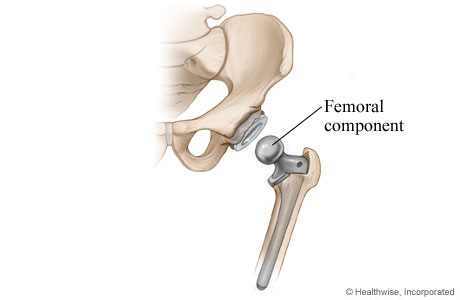What To Expect
On the day of surgery, you'll learn how to get in and out of bed. You'll also learn how to walk with a walker, crutches, or a cane. By the time you leave the hospital, you'll be able to safely sit down and stand up, dress yourself, use the toilet, and bathe.
As soon as possible, you'll start physical therapy. You'll learn exercises to help you get stronger. You'll also be taught how to move your body without dislocating your hip.
During the first week or so after surgery, you'll need less and less pain medicine. For a few weeks after surgery, you'll probably take medicine to prevent blood clots.
It usually takes a few months to get back to full activity. After you recover from surgery, you may have much less pain than before and a better quality of life.
Sometimes hip replacements have to be done again. It depends on your age, how much stress you put on the joint, and how well your new joint and bones mend. Your weight can make a difference. Every extra pound of body weight adds 3 pounds of stress to your new hip joint. Controlling your weight can help your new hip joint last longer. It should also last longer if you avoid hard physical work and sports that stress the joint.
In the future, make sure to let all health professionals know about your artificial hip so they will know how to care for you.
Precautions
If you have surgery through the side or back or your hip, you'll need to follow "hip precautions" until your hip is fully healed. Most often, this means that you:
- Keep your toes pointing forward or slightly out. Don't rotate your leg too far to the inside.
- Do not bend your hip more than 90 degrees. This means no bending forward while sitting down and no bending over to tie your shoes.
- Do not let your affected leg cross the center of your body toward the other leg. Your therapist may suggest that you:
- Do not cross your legs or feet.
- Be very careful as you get in or out of bed or a car. Make sure your leg does not cross the imaginary line down the middle of your body.
- Keep a pillow between your knees when you are lying down.
There are different precautions after anterior surgery. Your physical therapist will teach you how to move safely. For example, while you're healing, the therapist may suggest that you:
- Do not cross your legs or feet.
- Do not step backward or bend backward.
- Do not turn your leg too far out to the side. Keep your toes pointing forward or slightly in.
Exercise and activity
After traditional surgery, you'll slowly return to most of your activities.
- You'll need to use a walker, crutches, or a cane for the first few weeks after surgery. Your doctor will tell you when you can walk on your own.
- Your doctor will tell you when you can drive again.
- You may be able to go back to work in 4 weeks to 4 months. It depends on your job.
- Your doctor will tell you when you can do activities like swim, dance, golf, or ride a bike.
- You may need to avoid some strenuous activities. These may include running, horseback riding, tennis, and any type of skiing.
- For most people it is safe to have sex about 4 to 6 weeks after the surgery.
Learn more
- Using Cold and Heat Therapies





